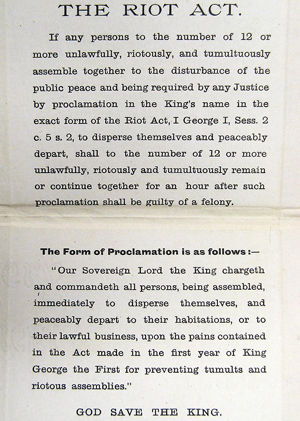
Has anyone ever “read you the Riot Act?” You may not have known that the Riot Act was passed by an act of the British Parliament on this date exactly 300 years ago, July 20, 1715.
The Riot Act authorized local authorities to declare any group of twelve or more people to be unlawfully assembled, and thus have to disperse or face punitive action. The Act came into force on August 1, 1715. It was repealed for England and Wales by the Criminal Law Act of 1967, and overall in Britain in 1973. A version is still in force in Canada.
The Riot Act was introduced during a time of civil disturbance in Great Britain, such as the Sacheverell riots of 1710, the Coronation riots of 1714 (against King George I), and the 1715 riots. The preamble makes reference to “many rebellious riots and tumults,” labeling them “heinous offenses.”
If local officials read the Riot Act, and the group failed to disperse within one hour, anyone remaining gathered was guilty of a felony without benefit of clergy, punishable by death.
The proclamation had to follow the precise wording detailed in the act; several convictions were overturned because parts of the proclamation had been omitted, in particular “God save the King.” The wording to be read aloud went as follows:
“Our Sovereign Lord the King chargeth and commandeth all persons, being assembled, immediately to disperse themselves, and peaceably to depart to their habitations, or to their lawful business, upon the pains contained in the act made in the first year of King George, for preventing tumults and riotous assemblies. God Save the King!”
Punishment by death could befall anyone preventing the reading of the proclamation, or damaging buildings while on a riot. If law enforcement officers happened to injure or kill a rioter, they were immune from prosecution. Owing to its broad authority, the act was used not only for the maintenance of civil order, but for political means and the gagging of labor as well.
Prosecutions under the Riot Act were restricted to within one year of the event. But another problem for civil authorities was actually reading the Riot Act during a serious disturbance. For example, after the 1819 Peterloo Massacre in Manchester, most of the demonstrators who were convicted claimed that they had not heard the Riot Act being read. The Riot Act was unsuccessful in controlling many other disturbances, including the 1743 Gin Riots, the 1768 St George’s Massacre and the 1780 Gordon Riots.
The United States has many similar laws inherited from British rule. Even when a demonstration or picket line is perfectly legal, an official order to disperse can be employed to hobble a legitimate protest movement. Even knowing that issuing such an order is inappropriate, authorities are usually confident that the courts will uphold their claims, and in any case cause the protesters damages in loss of time, arrest, imprisonment and lawyers’ fees, and perhaps loss of employment. The struggle for the proper balance between government and civil society continues!
Adapted from http://spartacus-educational.com/Lriot.htm, Wikipedia, Chase‘s Calendar of Events, and other sources (which differ as to the date the Riot Act was passed: Chase‘s uses this date).
The full Riot Act. The lower part contains the proclamation that was to be read aloud.
Photo: Wikipedia (CC)










